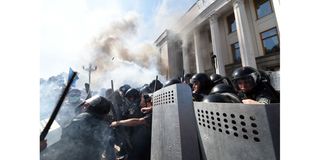Ending the fight in Ukraine

Smoke rises from the parliament building in Kiev as activists from radical Ukrainian parties, including the nationalist Svoboda, clash with police. PHOTO | AFP
As Russia/Nato passions are stirring once again, we should wind the clock back to seven years ago when the Ukraine crisis began. What’s it all about?
The demonstrators in the Maidan, the central square of the capital, Kiev, were motivated by the arguments over a trade agreement with the EU, then being negotiated. They were ardently for it but the government under Russian pressure had done a somersault and re-orientated its trade policy towards the Moscow-sponsored Eurasian Economic Union. In truth, Ukraine could have had both- just as the UK, until Brexit, had the EU and was negotiating the North Atlantic Free Trade Area simultaneously. But the EU and the US threw their weight behind the demonstrators and said Ukraine couldn’t face both ways.
After a few days the demonstrations turned violent. Although the Western press was slow to catch on, the demonstrators had been infiltrated by neo-fascists who fired first at the police and second at the more peaceful demonstrators. Some of the neo-fascists in the Svoboda and Right Sector parties, who trace their pedigree back to Nazi times, became snipers, firing from the 11th floor windows of the adjacent Hotel Ukraine. A BBC film aired footage of this. So did an Italian documentary. Nevertheless, Nato countries have ignored the evidence for this and have accused the then pro-Russian government of President Wiktor Yanukovych of instigating the shootings.
It’s now seven years since dissident militias threw off the yoke of the central government in Kiev and declared their de-facto independence. They were supported by Russian troops which at first president Vladimir Putin denied and then later admitted. It was the Russians who supplied the missile launcher that accidentally shot down a Malaysian Airlines passenger jet. Altogether 17,000 people, mostly civilians, have died in this conflict.
Negotiations, brokered by Germany and France, have been held on and off for seven years. The parameters of a settlement are easily put: in return for Donbass being granted a large amount of autonomy (it could be approximately the same as Scotland has today) Russian troops would withdraw and the militias disbanded.
Nevertheless, the gap between the positions of Moscow and Kiev appears almost impossible to bridge, not least because the central government has been slow to reform itself in the way that the Western negotiators have demanded. The US and the EU have tried to encourage it to move faster but rather than using economic and military pressure to get it to the starting line they have taken a soft approach, indeed sometimes going the wrong way with the US’s supply of sophisticated armaments to the Kiev government- a move which has really got under the Russians’ skin. It seems to have no rationale other than being needlessly macho. Ukraine could never go to battle with Russian troops on its own. Worryingly, Nato is now trying to make out that Russia’s latest troop movements are a precursor to a Russian invasion. There is no real evidence that President Vladimir would be so stupid.
There is one very appealing way to cut through the impasse. It is for Kiev to act unilaterally and announce it is giving up Donbass. Why not? It is a drain on Ukraine, both politically and economically and Donbass offers little to the rest of Ukraine except territory. Even now in the present day semi-frozen conflict Kiev is benefiting. It no longer has to subsidise what is in effect a rust belt of decaying industries and where unemployment is massive and inflation has soared. Nor does it have to deal with the region’s disproportionate number of corrupt oligarchs, political elites, and criminal gangs. Moreover, without the Donbass participating in Kiev’s decision making, the centre has been freer to push ahead with economic reforms and improving the quality of its governance. Indeed, much of the economic burden has fallen on Russia. No wonder that Kiev sometimes gives the impression it likes the status quo
Ukraine should count the benefits of letting Donbass go. The government could cut the costs for its military and no longer need to import expensive weaponry. If it succeeded in negotiations in winning Donbass back, the economist Anders Aslund estimates it would cost $20 billion to put Donbass on its feet again when Ukraine’s entire annual budget is around $26 million. The environmental damage caused by the fighting is immense.





